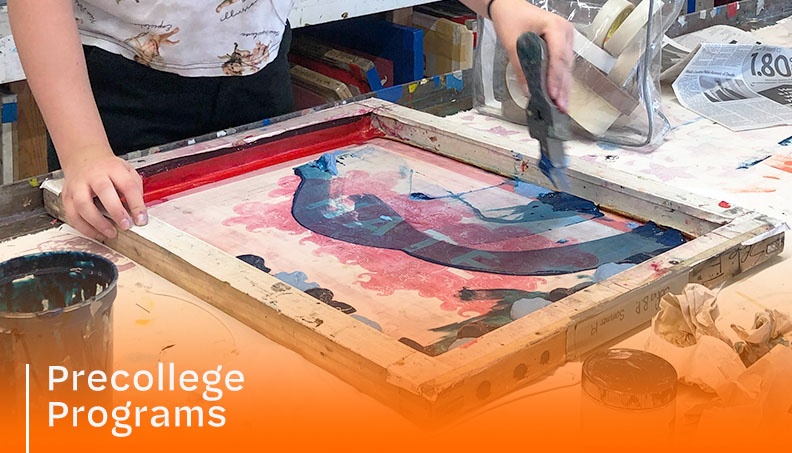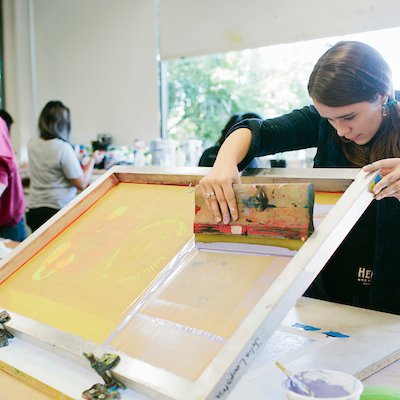Discover the Different Kinds Of Screen Printing Techniques for Your Next Task
Screen printing offers a varied series of techniques that can enhance any creative project. From standard approaches like serigraphy to modern-day advancements such as direct-to-garment printing, each method has its distinct benefits. Specialty alternatives, consisting of metallic and green inks, present a lot more possibilities. Recognizing these techniques can greatly affect the last end result. Nevertheless, the challenge hinges on selecting one of the most suitable method for specific needs and wanted effects. What factors should one think about?

The Basics of Screen Printing
Although screen printing might seem facility, it is fundamentally a simple process that includes transferring ink via a mesh screen onto numerous surface areas. The technique begins with the development of a pattern, which specifies the style to be printed. This pattern is connected to a mesh screen, commonly made of polyester or nylon. Once the pattern is in location, ink is used to the screen and pushed via the mesh using a squeegee, resulting in the wanted pattern being published on the underlying product.
Screen printing can be done on a large range of substrates, consisting of paper, plastic, and textile, making it a flexible selection for various projects. The procedure enables vivid shades and intricate styles, making it preferred in industries such as marketing, art, and style. Understanding these essentials equips people with the fundamental expertise needed to discover even more advanced strategies in screen printing.
Conventional Screen Printing Techniques
Standard screen printing techniques have actually been employed for centuries, protecting the craftsmanship and artistry of this technique. This technique uses a mesh screen to move ink onto a substratum, such as fabric or paper, permitting vibrant and durable styles. The process begins with producing a pattern, which obstructs particular locations of the screen to control where the ink will certainly be applied.
One prominent technique is serigraphy, frequently utilized for creative prints and limited editions. Another is the usage of water-based inks, which are environmentally friendly and offer a soft feel on textiles - 10:9 Design Abilene. Additionally, standard methods can include manual printing, where artisans use ink with a squeegee, ensuring precision and focus to information
These strategies stay valued in the market for their tactile quality and the distinct textures they produce, appealing to both consumers and creators who appreciate the heritage of screen printing.
Digital Screen Printing Innovations
As the demand for faster production and personalization in the printing sector has actually surged, digital screen printing developments have arised as a game-changer. This technology mixes conventional screen printing techniques with digital processes, permitting fast prototyping and elaborate styles that were previously tough to attain. One significant development is the intro of direct-to-garment (DTG) printing, which promotes top notch, full-color prints on various textiles without the requirement for displays. Furthermore, advancements in ink formulas have brought about eco-friendly choices that maintain dynamic shades while minimizing environmental influence. Making use of automated systems further streamlines manufacturing, lowering labor expenses and improving accuracy. These developments not only satisfy tiny batch orders and individualized designs yet likewise permit for quicker turn-around times, making them perfect for services concentrated on meeting client needs in a fast-paced market. Digital screen printing, consequently, represents an important evolution in the domain of printing methods.
Specialty Screen Printing Approaches
Checking out specialty screen printing approaches reveals a diverse range of techniques that push the boundaries of creative thinking and functionality in the printing sector. Among these, glow-in-the-dark inks provide a distinct aesthetic result, making styles come active in low-light conditions. Metal inks, understood for their glittering coating, include a touch of luxury to published materials. One more innovative approach is discharge printing, which removes dye from the textile as opposed to adding ink, leading to a soft, vintage feeling. High-density printing develops a raised structure externally, enhancing tactile involvement. Additionally, water-based inks are acquiring popularity for their vibrant shades and reduced environmental influence. Each of these specialized strategies satisfies certain design requirements, allowing artists and brands to produce standout products that reverberate with their audiences. By leveraging these methods, businesses can boost their screen printing jobs to brand-new elevations, making sure memorable impacts.
Eco-Friendly Screen Printing Options
Environmentally friendly screen printing choices are acquiring traction as the market moves towards sustainability. Lasting ink options and the usage of naturally degradable materials are crucial components in lowering the environmental influence of the printing process. By taking on these practices, screen printers can add to a more lasting future while keeping top quality outcomes.
Lasting Ink Choices

Biodegradable Materials Use
As the screen printing industry progresses, the consolidation of naturally degradable products is becoming progressively crucial for ecologically aware techniques. Designers and makers are now exploring inks and substrates made from all-natural, renewable sources that break down a lot more successfully than typical equivalents. These naturally degradable alternatives decrease plastic waste and lessen environmental impact, straightening with the growing demand for sustainable products.
Common instances include water-based inks and organic cotton fabrics, both of which lessen unsafe chemicals and advertise eco-friendliness. Brands that take on these products commonly improve their market appeal, bring in consumers that prioritize sustainability. As awareness of ecological problems remains to climb, the change in the direction of naturally degradable products in screen printing is likely to obtain energy, cultivating a greener industry standard.
Selecting the Right Technique for Your Project
Just how can one figure out the most suitable screen printing method for a specific project? The decision pivots on a number of variables, consisting of the material to be published on, the intricacy of the style, and the wanted production quantity - 10:9 Design Abilene. For example, direct-to-garment printing is ideal for intricate layouts with many colors, while typical screen printing succeeds for bigger runs of simpler graphics
In addition, factor to consider of the end-use of the printed item is essential. For exterior applications, methods that use longevity and weather condition resistance, such as plastisol ink, may be liked. Conversely, environmentally-conscious projects may profit from eco-friendly products or water-based inks.
Eventually, understanding the job's unique requirements permits an informed option, guaranteeing both visual appeal and practical longevity. By assessing style complexity, product compatibility, and production range, one can successfully select the most proper screen printing technique to meet their project's objectives.
Often Asked Inquiries
What Is the Background of Screen Printing?
Screen printing originated in old China around 1000 AD, advancing through Japan and Europe. By the 20th century, it ended up being prominent in business art and style, changing exactly how layouts were produced and dispersed internationally.

Exactly how Do I Prepare Artwork for Screen Printing?
To prepare artwork for screen printing, one must ensure high resolution, utilize an ideal color setting, create different here layers for every color, and transform message to lays out, guaranteeing compatibility with the printing process and preferred outcome.
What Materials Are Finest for Screen Printing?
The best materials for screen printing include top quality inks, resilient screens, and ideal substrates like cotton, polyester, or blends. Additionally, using proper emulsion and mops can boost the printing procedure and results.
Can I Evaluate Publish in your home?
Yes, screen printing in the house is possible. With the ideal materials, configuration, and techniques, individuals can develop high-quality prints. Mindful factor to consider of office and devices is vital for successful results.
What Are Typical Mistakes in Screen Printing?
Usual blunders in screen printing consist of improper direct exposure times, poor ink consistency, imbalance of displays, insufficient cleaning of products, and overlooking to test prints. These mistakes can endanger the quality and precision of the final item.
Screen printing may appear complicated, it is fundamentally an uncomplicated process that involves transferring ink through a mesh screen onto various surface areas. As the need for faster production and modification in the printing industry has risen, electronic screen printing innovations have actually arised as a game-changer. Exploring specialty screen printing techniques discloses a diverse range of techniques that push the borders of creative thinking and functionality in the printing sector. The best materials for screen printing consist of premium inks, resilient displays, and ideal substratums like cotton, polyester, or blends (10:9 Design contact). Typical errors in screen printing consist of incorrect direct exposure times, poor ink uniformity, imbalance of screens, inadequate cleansing of materials, and overlooking to examine prints